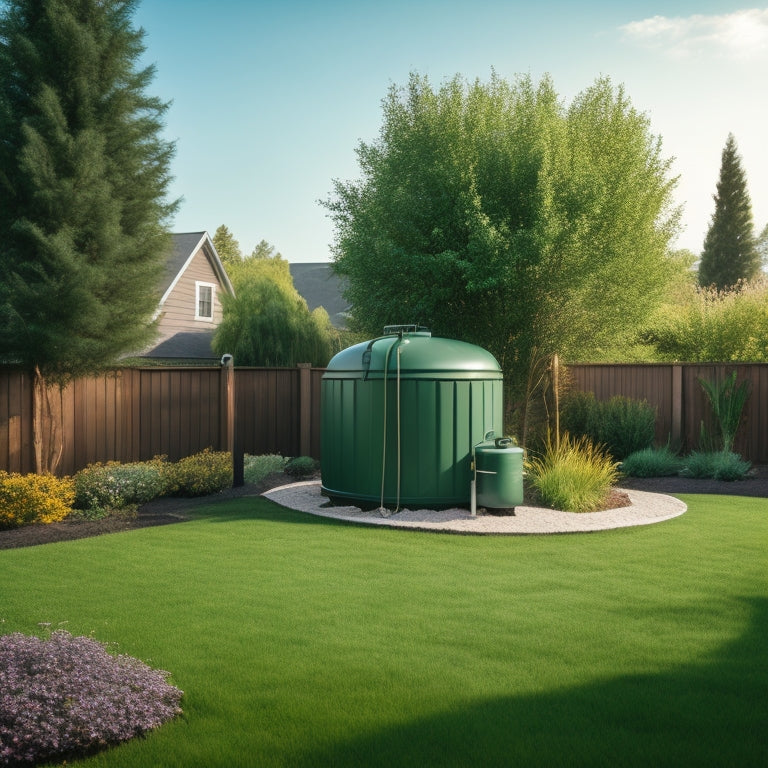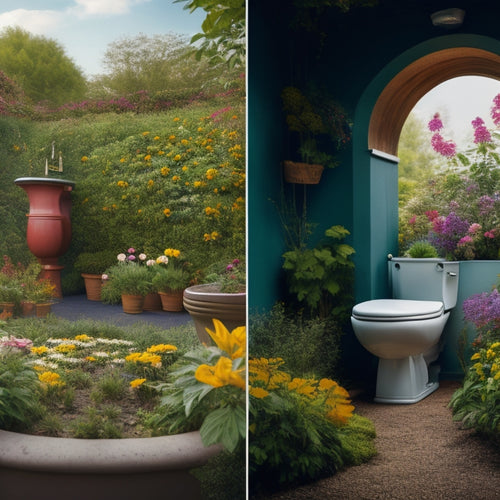
10 Lawn-Saving Rainwater Collection Tips for Tech-Savvy Homeowners
Share
As a tech-savvy homeowner, you're taking a step towards sustainable lawn care by utilizing rainwater collection. To optimize your system, you'll need to evaluate your water needs based on evapotranspiration rates, lawn size, and climate. Choose durable, eco-friendly materials for your collection system, and select ideal collection points by analyzing roof runoff patterns. Install a first flush device to guarantee clean water enters your storage tank, and size your tank based on maximum rainfall potential. With the right setup, you'll be able to collect and conserve rainwater efficiently, and as you investigate these tips, you'll uncover even more ways to fine-tune your system for a lush, healthy lawn.
Key Takeaways
- Calculate lawn water needs based on evapotranspiration rates, adjusting for seasonal changes, to ensure optimal water collection and usage.
- Select durable, UV-resistant materials for collection and storage systems, and consider eco-friendly options like recycled plastic or bamboo.
- Install a first flush device to divert initial contaminated water flow from the roof, ensuring clean water enters the storage tank.
- Regularly inspect and maintain the collection system, including gutters and downspouts, to prevent debris accumulation and ensure efficient operation.
- Implement overflow management strategies, such as float valves and overflow pipes, to prevent water waste and erosion.
Assessing Your Water Needs
Before you start collecting rainwater, it's essential to determine how much water you need for your lawn. This calculation sets the foundation for your rainwater harvesting system.
You'll need to take into account factors like lawn size, soil type, and climate. For accurate rainwater calculations, calculate your lawn's weekly water requirement based on evapotranspiration rates.
Make seasonal adjustments to account for variations in rainfall and temperature. For instance, you'll need more water during hot summer months and less during cooler winter months.
As you design your system, think about integrating solar-powered energy solutions to reduce your reliance on grid electricity.
Choosing the Right Materials
As you begin designing your rainwater collection system, selecting the right materials is crucial to guarantee durability, efficiency, and cost-effectiveness.
You'll want to choose materials that can withstand outdoor weather conditions and support the weight of collected water. Look for materials with high durability, such as UV-resistant polyethylene or stainless steel, which can last for decades.
Additionally, consider eco-friendly options like recycled plastic or bamboo, which can reduce your environmental footprint.
When it comes to reducing greenhouse gas emissions, incorporating renewable energy solutions into your design can greatly impact your system's sustainability. By leveraging hybrid electric solutions or biodiesel fuel systems, you can further minimize your carbon footprint.
When selecting pipes and fittings, verify they're compatible with your collection system and can handle varying water pressure.
Selecting Ideal Collection Points
You'll need to analyze your roof's runoff patterns to identify the finest collection points, as this will help you determine where water tends to flow and accumulate.
By mapping out the water flow paths on your property, you can pinpoint the areas where collection will be most effective.
When considering renewable energy options, solar panel efficiency is vital to maximize energy generation.
Ideal placement of your collection sites will depend on these factors, so it's important to get it right.
Roof Runoff Analysis Needed
Your roof is the primary source of rainwater collection, and its design and layout play a crucial role in determining the ideal collection points. To maximize your rainwater harvesting system's efficiency, you need to analyze your roof's runoff management. This involves understanding your roof's drainage design, including the slope, size, and material.
By examining these factors, you can identify areas where rainwater tends to collect and flow. Implementing solar-powered systems, like those used in solar-powered EV charging, can also reduce your reliance on traditional power sources and lower your carbon footprint.
This knowledge will help you pinpoint the best spots to install your collection system, ensuring you capture the most water possible. A thorough roof runoff analysis will also help you avoid potential issues like clogged gutters and downspouts, ensuring your system operates smoothly and efficiently.
Identify Water Flow Paths
Identify Water Flow Paths (Selecting Ideal Collection Points)
You're ready to pinpoint the perfect spots to collect rainwater. To do this, observe your property's drainage patterns during a heavy downpour. Notice how surface runoff flows across your lawn and around your home. Look for natural low points, slopes, and areas where water tends to accumulate. These areas are prime candidates for rainwater collection.
Take note of the direction water flows from your roof, too. Is it towards a specific corner or side of your home? As you plan your rainwater collection system, consider incorporating sustainable road trip amenities that not only conserve water but also promote eco-friendly practices.
By integrating renewable energy sources and energy storage systems, you can create a self-sustaining system that reduces your carbon footprint. Use this information to identify the most effective locations for your rainwater collection system.
Optimize Collection Site Placement
As heavy rainfall hits your property, water flows across your lawn and around your home, revealing natural low points and slopes where collection sites can be ideally placed. To optimize collection site placement, consider the following environmental factors:
| Environmental Factor | Impact on Collection Site | Optimization Tip |
|---|---|---|
| Slope | Water flows downhill, increasing collection efficiency | Place collection sites at natural low points or near downspouts |
| Vegetation | Dense vegetation can obstruct water flow | Trim or remove vegetation around collection sites |
| Soil Type | Permeable soil can reduce collection efficiency | Choose collection sites with impermeable soil or use a liner |
| Nearby Obstacles | Obstacles can divert water flow | Position collection sites at least 10 feet away from obstacles |
| Wind Direction | Wind can affect water flow and collection | Place collection sites on the leeward side of your home |
Installing a First Flush Device
You're about to install an essential component in your rainwater harvesting system: a first flush device.
This clever device allows the initial flow of water from the roof to be diverted, taking any debris and contaminants with it, and then allows clean water to flow into your storage tank.
Device Functionality Explained
Installing a first flush device is an essential step in rainwater collection, as it allows you to redirect the initial flow of water from the roof, which often carries debris and contaminants, away from your storage tank.
This device is equipped with smart sensors that detect the first flow of water from the roof and redirect it, ensuring that only clean water enters your storage tank.
-
The device automatically reroutes the initial flow, allowing clean water to flow into the tank.
-
You can monitor the device's performance through app integration, receiving real-time updates on water quality and tank levels.
-
With a first flush device, you can rest assured that your rainwater collection system is working efficiently and effectively, giving you the freedom to harvest and employ rainwater without worrying about contaminants.
Installation Best Practices
When positioning your first flush device, consider the distance between the roof's downspout and the storage tank to guarantee a seamless connection.
Make certain the device is installed at a slight angle to allow debris to flow out of the system. For gutter systems with multiple downspouts, consider installing a first flush device on each downspout to maximize efficiency.
When choosing rain barrel types, opt for ones with a built-in first flush system or attach a separate device to the downspout.
Properly installing your first flush device will prevent contaminants from entering your storage tank, making sure you collect clean rainwater for your lawn and garden.
Maintenance Simplified
With a first flush device in place, debris and contaminants are kept at bay, allowing you to focus on the task at hand: maintaining your rainwater collection system.
This device guarantees that the initial flow of water from the roof, which may contain debris, is diverted, and only clean water enters your storage tank.
-
Make seasonal adjustments to your system to optimize performance, such as cleaning gutters and downspouts during fall.
-
Schedule regular inspections to identify potential issues before they become major problems.
-
Consider system upgrades, such as adding a secondary filtration system, to improve water quality and extend the life of your equipment.
Sizing Your Rainwater Tank
Determine your rainwater tank's capacity by calculating the maximum amount of rainfall your roof can collect during a storm. Consider factors like roof size, material, and pitch, as well as the intensity of rainfall in your area.
| Roof Size (sq ft) | Average Annual Rainfall (in) | Recommended Tank Capacity (gal) |
|---|---|---|
| 1,000 | 30 | 6,000 |
| 2,000 | 40 | 12,000 |
| 3,000 | 50 | 18,000 |
| 4,000 | 60 | 24,000 |
| 5,000 | 70 | 30,000 |
Remember to balance tank capacity with space considerations. You'll want to verify your tank fits comfortably in your yard or garage without obstructing traffic or access.
Connecting to Irrigation Systems
When you connect your rainwater collection system to your irrigation system, you'll need to decide on a system integration option that works for you, whether that's a simple gravity-fed setup or a more complex pumping system.
You'll also want to contemplate implementing automated watering schedules to optimize water distribution and reduce waste.
System Integration Options
Your lawn's thirst for water can be quenched without depleting your wallet or the municipal water supply.
By integrating your rainwater collection system with your irrigation system, you can enjoy a lush, green lawn while saving money and resources.
To take your system to the next level, consider the following integration options:
-
Smart sensor integration: Connect your rainwater collection system to smart sensors that monitor soil moisture levels, allowing your irrigation system to automatically adjust watering schedules based on real-time data.
-
Data integration with weather forecasts: Integrate your system with local weather forecasts to anticipate and prepare for upcoming rainfall or droughts, ensuring your lawn receives the right amount of water at the right time.
-
Automated valve control: Use data from your rainwater collection system to control valves that redirect water to your irrigation system, ensuring seamless and efficient water distribution.
Automated Watering Schedules
Rainwater-harvesting homeowners can breathe a sigh of relief with automated watering schedules that seamlessly connect to their irrigation systems.
You can optimize water distribution with smart irrigation controllers that adjust watering frequencies based on real-time weather data from integrated weather sensors.
Moisture monitoring sensors guarantee your lawn receives the right amount of water, preventing overwatering and underwatering.
With app integration, you can remotely control and schedule watering sessions, receiving notifications and data analytics to refine your drought planning strategy.
System automation allows you to set customized watering schedules, and remote control capabilities give you freedom to manage your irrigation system from anywhere.
Adding a Float Valve System
As you design your rainwater collection system, incorporating a float valve system is an essential step to guarantee efficient water storage and distribution.
This mechanism guarantees your tank never overflows, reducing water waste and preventing damage to your property.
When selecting a float valve, consider the following factors:
-
Choose from various float valve types, such as mechanical, electrical, or pneumatic, based on your system's specific needs and budget.
-
Confirm proper float valve installation to avoid leaks and malfunctions, which can lead to water loss and system failure.
-
Consider the valve's flow rate and pressure to confirm it can handle the water volume and pressure in your system.
Implementing Overflow Management
With your float valve system in place, it's time to focus on the next essential component of your rainwater collection system: managing overflows. Overflow prevention strategies are vital to prevent waterlogging, erosion, and property damage. You'll need to implement rainwater diversion techniques to redirect excess water away from your home and garden.
| Overflow Prevention Strategies | Rainwater Diversion Techniques | Benefits |
|---|---|---|
| Overflow valves | Redirect excess water to storm drains | Prevents waterlogging and erosion |
| Overflow pipes | Divert excess water to nearby green spaces | Reduces stormwater runoff and property damage |
| First flush devices | Allow initial rainfall to flush debris, then direct clean water to storage | Improves water quality and reduces maintenance |
| Rainwater diversion ponds | Create artificial ponds to capture and slowly release excess water | Enhances biodiversity and aesthetic appeal |
Maintaining Water Quality Standards
Quality is key when it comes to the water you collect and store. You want to guarantee it's safe for your lawn and the environment. To maintain water quality standards, you'll need to implement a few essential measures.
-
Use a reliable water filtration system to remove debris, sediment, and contaminants from your collected rainwater.
-
Conduct regular quality testing to monitor pH levels, turbidity, and bacterial growth.
-
Make seasonal adjustments to your collection and storage systems to minimize environmental impact, such as reducing algae growth during summer months.
Monitoring and Adjusting Flow
You've confirmed the collected rainwater meets quality standards, now it's time to focus on the flow. Monitoring and adjusting flow rates is vital to optimize your rainwater harvesting system.
Install flow sensors to track the rate of water collection and alert you to any changes. This data will help you identify potential issues, such as clogged gutters or downspouts, and make adjustments to maintain a smooth flow.
Combine flow sensor data with rain gauge readings to fine-tune your system. By monitoring flow rates, you'll guarantee your system operates efficiently, reduces waste, and provides a reliable water supply for your lawn.
With real-time data, you'll be in control, making adjustments as needed to maximize your rainwater harvesting system's performance.
Frequently Asked Questions
Can I Use Rainwater for Washing Machines and Dishwashers?
Imagine sailing through a sea of soap suds, steering towards a bounty of water independence! You can utilize rainwater for washing machines and dishwashers, but first, guarantee proper rainwater filtration and appliance compatibility to avoid any stormy surprises.
Are There Any Local Regulations on Rainwater Harvesting Systems?
You'll need to research local harvesting guidelines, as they vary; some areas require system permits, while others incentivize rainwater collection, so it is crucial to understand the regulations in your area before installing a system.
Can I Connect My Rainwater Tank to My Home's Plumbing System?
Did you know 50% of household water is used for non-potable purposes? You can connect your rainwater tank to your home's plumbing system, but you'll need to install rainwater filtration systems and make plumbing modifications to guarantee safe, potable water supply.
How Do I Prevent Mosquito Breeding in My Rainwater Collection System?
You'll guarantee mosquito control by incorporating fine-mesh screens, tight-fitting lids, and regular rainwater maintenance, such as cleaning gutters and downspouts, to prevent stagnant water and deny breeding sites, keeping your collected rainwater safe and healthy.
Can I Use Rainwater for Drinking or Cooking Purposes?
Imagine a revitalizing oasis, but beware, unfiltered rainwater can be a poisoned chalice. You'll need sturdy rainwater filtration to guarantee it's safe for drinking and cooking, considering health implications like bacterial contamination and chemical pollutants.
Related Posts
-

Why Transform Human Waste Into Garden Gold?
By changing human waste into garden gold, you'll reduce waste management costs, support sustainable agriculture, and ...
-

Green Deck Options: Earth-Conscious Choices for Your Home
You're looking for a deck that not only enhances your home's exterior but also aligns with your eco-friendly values. ...
-

What Air Purifiers Save Energy in Work Areas?
You can cut energy costs and reduce your carbon footprint by choosing air purifiers designed with energy efficiency i...


